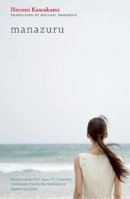

Counterpoint, hardcover, 9781582436272
Kei Yanagimoto's husband walked out without explanation and without a breath of further contact with her or their three year old daughter, leaving her in a strange limbo for twelve years, at which point we step into her story. With the first line, "I walked on, and something was following", we are made aware that we are entering a place where the usual rules might not apply. At first I wasn't certain that it would be one that I would be able to connect with: would the metaphors translate across our very different cultures? Would I even be able to grasp what was going on?
Happily, the answer is yes. Once I unhooked my mind from certain expectations, the universal themes of rejection, of loss without resolution, of grief, and of rebirth, worked their way out of the often surreal world Hiromi Kawakami has created in Manazuru to deliver their message with surprising solidity.
Why "surprising"? Well, we don't quite know—and I think this is intentional on Ms. Kawakami's part—when we are solidly in the "real" world or when we are in the world between Kei's ears where memories assume the force of hauntings. Or perhaps we are in another kind of place altogether, where the veil between life and death is less opaque for Kei than it is for the rest of us. Kei herself doesn't seem to know. We travel with her to Manazuru, never quite certain what this place is and why she (and we) must keep going there. There are times when we lose all sense of what is real as we move through a surreal landscape of lashing rains, sinking boats and ancient shrines. We are never quite certain who is alive and who might be dead. At times I felt that I too was "something following", one of the ghostly forms at her shoulder, silently observing, equally questing.
In counterbalance is the grounding presence of the sturdily real: her daughter's teenage angst, her mother, her married lover, the smells and flavours of food, the impact of colour, all forms of the natural and manmade world around her. Kei sees these things with particular acuity. As the story progressed, I began to appreciate the degree to which Kei is unusual. With her dislike of being touched, her difficulty in saying her husband's name out loud to him, her attitude about her baby after Momo was born, her strangely conscious decisions about emotions, Hiromi Kawakami has drawn the complex personality of Kei so that we accept without question why it has taken her twelve years to fully acknowledge her grief's existence. We are, we understand, glimpsing the subconscious of an artist.
Manazuru is the story of Kei's journey towards her own understanding. What could have been a stereotypical
slog through a quagmire of negative emotions is instead a series of walks or train rides or visits to parks, through
scenes as delicate as paintings. No muscling to the ground of metaphor or analogy is required, a simple receptive
quietness will do, even when storms rage and boats sink. For all the dark places it explored, the story left me
feeling calm and meditative, particularly with its shining ending.
